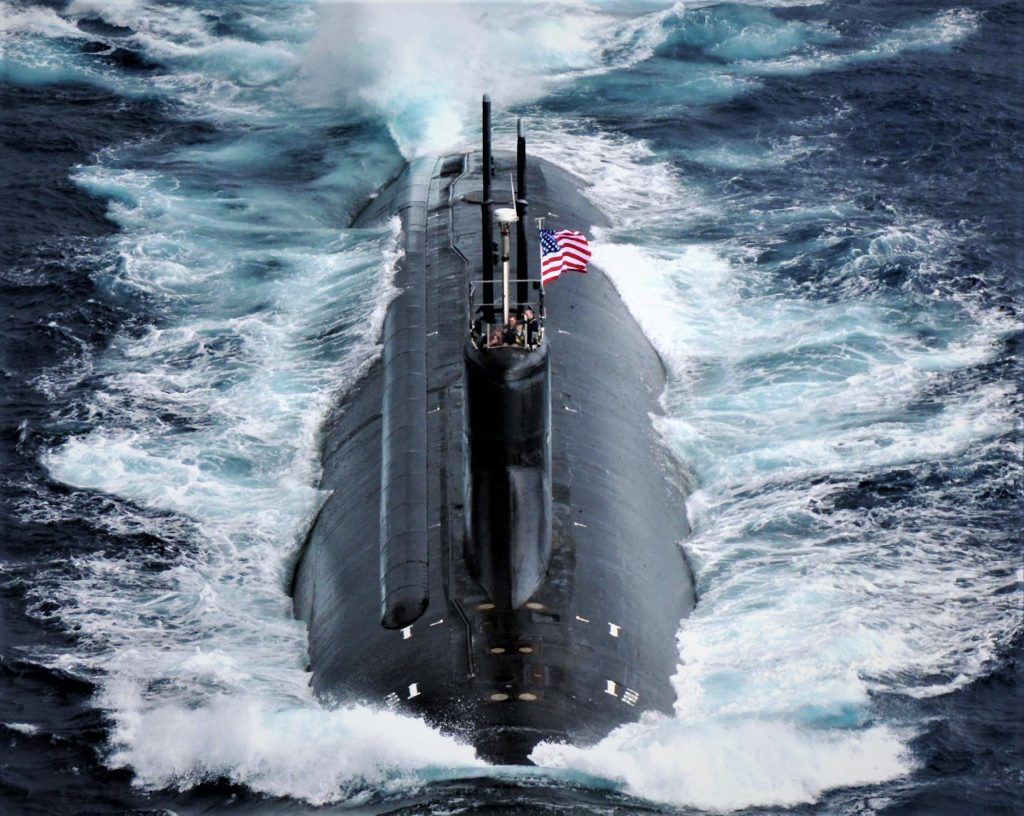
Nearly a dozen sailors were injured when a USN nuclear powered attack submarine hit an identified submerged object in the South China Sea a few weeks ago. The Seawolf-class nuclear attack submarine USS Connecticut SSN-22 was involved in an underwater collision while operating in international waters.
In a statement concerning the incident, the Navy’s Pacific Fleet said that “The Seawolf-class Fast Attack submarine USS Connecticut SSN-22 struck an object while submerged on the afternoon of Oct. 2, while operating in international waters in the Indo-Pacific region. There were no life-threatening injuries.” It went on to say that “After the collision, the submarine remained in a safe and stable condition and Connecticut’s nuclear propulsion plant and internal spaces were not affected and remained fully operational. The extent of damage to the remainder of the submarine is being assessed at this time. The Navy did not request outside assistance and the incident is under investigation.”

A defense official confirmed that about 11 sailors were hurt in the incident with two sailors aboard the submarine being treated for what a Navy official described as “moderate injuries” and additional sailors received bumps, minor bruises, and lacerations. Afterward, the Attack boat headed to Guam on the surface to undergo damage assessment and preliminary repairs. Initially, Officials said it remained unclear what the submarine struck and that the possibilities could include stationary objects like a seamount, an underwater mountain, an object being towed by a surface vessel, or submerged debris such as a cargo container.
The Kitsap-Bremerton, WA based submarine had deployed on May 27 for the western Pacific with port calls planned in Japan in late July and August. Connecticut is one of three Sea Wolf-class boats, an end of Cold War era attack submarine designed to hunt the most complex high speed, deep-diving Soviet submarines. Along with USS Sea Wolf SSN-21 and USS Jimmy Carter SSN-23, Connecticut is among the Navy’s most technologically advanced and nuclear capable attack boats ever constructed. The last known incident where a USN submarine struck another underwater body was in 2005 when USS San Francisco SSN -711 struck a submerged mountain at flank speed off the coast of Guam. One sailor was killed in that incident. And, although the extent of Connecticut’s damages has yet to be determined, San Francisco’s ran into the billions of dollars and involved having the bow section of sister submarine USS Honolulu SSN-718, scheduled to be retired, removed and installed onto San Francisco.
Investigators have ultimately determined that USS Connecticut hit an uncharted seamount that grounded the nuclear attack submarine on the underwater feature of the Continental Slopes in the South China Sea. The largest marginal sea on the continental shelf of Southeast Asia is among the most significant shelf-margin basins in the world. And its deep portion, called the China Sea Basin, has a maximum depth of 16,457 feet and an abyssal plain with a mean depth of some 14,100 feet.
7th Fleet spokesperson Cmdr. Hayley Sims in an official statement said that “The investigation determined USS Connecticut grounded on an uncharted seamount while operating in international waters in the Indo-Pacific region. Commander, U.S. 7th Fleet will determine whether follow-on actions, including accountability, are appropriate.”
The impact to the forward section of the submarine damaged its main ballast tanks (MBTs) and prompted Connecticut to make a week-long voyage on the surface from the South China Sea to Guam. The Navy has said repeatedly that the submarine’s nuclear reactor and propulsion system are undamaged.

The boat has proceeded to Guam to undergo initial repairs overseen by Naval Sea Systems Command, personnel from the Puget Sound Naval Shipyard and submarine tender USS Emory S. Land (AS-39). The Navy will first determine how the submarine can be fixed well enough to safely leave Guam for follow-on repairs. And determining where and when the final repairs would occur will further stress the service’s maintenance capability. “If we ended up doing the Connecticut work in one of the public shipyards, that would certainly cause perturbations in all the other work in the shipyards,” Jay Stefany, acting assistant secretary of the Navy for research, development and acquisition told the House Armed Services Committee readiness subcommittee in reference to the collision.
The damage and subsequent repairs to the attack submarine have caused renewed attention on the Navy’s attack submarine maintenance backlog. In the same hearing, House Armed Services sea power and projection forces subcommittee chair Rep. Joe Courtney (D-Conn.) pointed out the lack of dry dock facilities for submarine repairs west of Hawaii. “Right now, it’s in Guam, that’s public record, there is no dry dock in Guam, hopefully, a sub tender can do the work, but that remains to be seen,” he said. “It just shows how … the world gets a vote and things change and unexpected incidents create more demand for repairs. … The attack subs have always been the poor cousin in the public shipyards in terms of getting priority, but we know particularly a Seawolf-class submarine is extremely valuable in terms of the mission in that part of the world.” Connecticut is one of three Sea Wolf-class attack nuclear boats that were developed for deep-water operations to take on Soviet submarines in the open ocean. Since the end of the Cold War, the trio has been upgraded and modified to carry out some of the Navy’s most sensitive covert missions.
Ultimately, the commander, executive officer and senior enlisted sailor, Chief of the Boat (COB), for the submarine USS Connecticut have been fired following the results of an investigation into the Oct. 2 incident. Connecticut’s commanding officer Cmdr. Cameron Aljilani, executive officer Lt. Cmdr. Patrick Cashin and Chief of the Boat (COB) Cory Rodgers were removed from their positions at the direction of U.S. 7th Fleet commander Vice Adm. Karl Thomas.
Their reliefs are “due to loss of confidence. Thomas determined sound judgment, prudent decision-making, and adherence to required procedures in navigation planning, watch team execution and risk management could have prevented the incident,” reads a statement from the Navy.
“Capt. John Witte will assume duties as interim Commanding Officer. Cmdr. Joe Sammur will assume duties as interim Executive Officer, and Command Master Chief Paul Walters will assume duties as interim Chief of the Boat.
Submarines hitting things while submerged are not necessarily as uncommon as one might think. As just in February of this year, the Japanese submarine Soryu hit a cargo ship while surfacing in the Pacific Ocean. And in 2016, the U.K. Royal Navy’s Astute class nuclear attack submarine HMS Ambush also suffered an underwater collision with a commercial tanker off the coast of Gibraltar. Too, the U.S. Navy has had its share of these kinds of accidents have had a submarine Incident off Kildin Island when a collision between the USN nuclear submarine USS Baton Rouge SSN-689 and the Russian Navy nuclear submarine B-276 Kostroma collided near the Russian naval base of Severomorsk on 11 February 1992. And on November 19th, 1969 in the Barents Sea, the Soviet missile submarine K-19 of The Widow Maker movie fame collided with the U.S. Navy attack submarine USS Gato SSN-615. Also, the notorious collision on 9 February 2001, about nine nautical miles south of Oahu, Hawaii in the Pacific Ocean, when the United States Navy Los Angeles-class submarine USS Greeneville SSN-772 collided with the Japanese-fishery high-school training ship Ehime Maru. When in a demonstration for some VIP civilian visitors, Greeneville performed an emergency ballast blow surfacing maneuver and as the submarine shot to the surface, it struck Ehime Maru. Within 10 minutes of the collision, Ehime Maru sank and tragically nine of the thirty-five people aboard were killed; four high-school students, two teachers, and three crew members.
It may seem perplexing as to how a multi-billion-dollar nuclear submarine that is crammed with some of the most sophisticated technology available on the planet and is one of the most advanced vehicles mankind has ever built can just run into something while cruising below the waves. It’s because submarine navigation requires very detailed information concerning the immediate surrounding area. And there are two common methods utilized for achieving safe, submerged navigation; detailed charts and active high-frequency sonar.
Highly accurate charts are always the first choice and active sonar transmissions are used to confirm that the water depth checks with the chart. Active sonar pulses can be transmitted in front and to the sides of modern submarines and short-range, high-frequency sonar systems reveal nearby underwater objects with great clarity. Submerged objects, such as mines, wrecks, and other submarines are plainly visible to a trained sonar operator.
However, the downside to the use of active sonar is that it is detectable by “enemy” vessels, and at approximately two times the range it allows the operator to search in most ocean environments. Therefore, a typical high-frequency, high-resolution sonar may see out to 5,000 yards and is vulnerable to detection out to least 10,000 yards or farther in good conditions. This means an adversary can pinpoint a submarine’s position, and it can remain undetected while trailing the active-sonar emitting submarine for as long as it uses its high-resolution sonar.
So, this vulnerability to detection is why active sonar is rarely used. And If bottom-mapping sonars verify the submarine’s position on the chart, there is less need to use a high-frequency, forward-looking sonar that may reveal their position.
So, in essence, submarines are “flying blind” at high speeds under the world’s oceans and therefore accidents are bound to happen, and they do. It’s a tribute to the training and skills of submariners that there aren’t more of them. So, riding a sub is almost stupid dangerous and submarining definitely isn’t for the faint of heart. But hell, I’d do it again just for the thrill.
